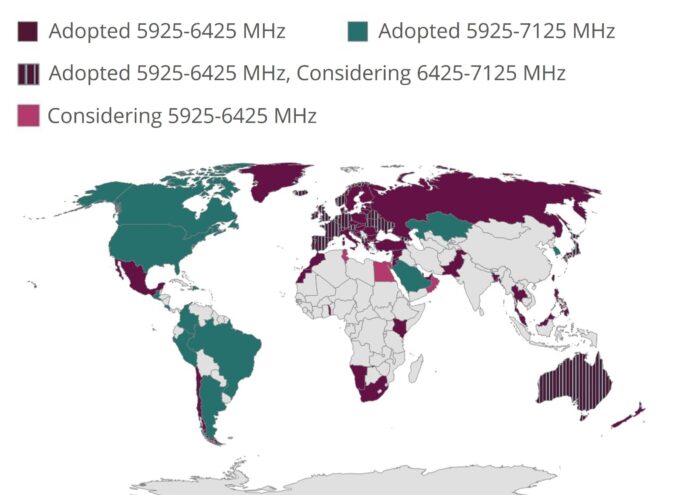IDC predicts that 807.5 million 6 GHz Wi-Fi devices will ship in 2024, up 66% in 2023
In April 2020, the U.S. Federal Communications Commission (FCC) officially opened up the 6 GHz band for unlicensed Wi-Fi use, resulting in the introduction of Wi-Fi 6E, and in turn, faster speeds and increased capacity. While the United States was quick to adopt all of the band (5925-7125 MHz) for Wi-Fi use, the response from the rest of the world varied greatly.
Today, 63 countries, including Turkey, Thailand, France, Guatemala, Argentina, Austria, Bahrain and the Faroe Islands have adopted either all (5925-7125 MHz) of the 6 GHz band or at least some of it, according to the Wi-Fi Alliance. Many countries are still considering opening up the band — like Egypt and Tunisia — or opening up more of the band — like the United Kingdom, which has, thus far, only opened up 5945-6425 MHz for Wi-Fi use. Still, others like China, chose instead to allocate the 6 GHz band for 5G and 6G services.
However, IDC has found 6 GHz momentum to be strong, with 807.5 million 6 GHz Wi-Fi — 6E and 7 — device shipments predicted for 2024, up 66% in 2023. The firm also expects that 147.2 million Wi-Fi 6E access points (APs) and 23.12 million Wi-Fi 7 APs will ship this year.
6 GHz and Wi-Fi 7
When it comes to Wi-Fi 7 specifically, IDC said 231.4 million device shipments are expected in 2024, accounting for 5.7% of Wi-Fi device shipments this year.
Wi-Fi 7, certified by the Wi-Fi Alliance in January 2024, was built from the ground up with the 6 GHz in mind. As such, some of its most exciting features and use cases — augmented, virtual, and extended reality (AR/VR/XR), ultra high definition video streaming and Industrial IoT — depend on the capabilities on use of the 6 GHz band.
For example, 6 GHz is necessary to benefit from Wi-Fi 7’s support of 320 MHz channels, double the 160 MHz of Wi-Fi 6. These ultra-wide channels deliver twice the throughput of Wi-Fi 6, enabling multigigabit speeds. Despite the lack of global harmonization around 6 GHz allocation, Gabriel Desjardins, director of product marketing in Broadcom’s Wireless Connectivity Division told RCR Wireless News in a previous conversation that early 320 MHz adoption indicates that this capability will be “mainstream” in Wi-Fi 7 and 8.
“Virtually every Access Point has 320 MHz support in the 6 GHz band and a high percentage of phones and PCs support 320 MHz,” Desjardins said. He noted that handset volumes on the market are split right now between 160 and 320 MHz. “We believe the market is moving entirely to 320 MHz in the near future,” he added, saying as well that he expects similar penetration for the Access Point (AP) market, as the benefit there is also apparent: “Basically, at every point in your home, you’re going to get higher throughput with a Wi-Fi 7 AP than with 6E or 6,” he said.
Further, Intel recently found that of the 269 Personal Computing Devices on the market, such as notebooks, desktops and tablets, 87% support 320 MHz while just 13% only support up to 160 MHz. The company further reported that Wi-Fi 7 has ramped 2.3x faster than Wi-Fi 6E one year after the Wi-Fi Alliance Certification launch.1
At the time of Wi-Fi 7’s certification, David Coleman, director of wireless in the Office of the CTO at Extreme Networks, said: “We are still at the dawn of the 6 GHz era, heralded by Wi-Fi 6E and we are poised to unlock unprecedented wireless user experiences. Wi-Fi 7, which is the next step of this evolution, signifies more than an incremental upgrade — it’s a leap into a realm where speed, capacity and reliability converge to meet the insatiable demands of our connected world.”
- Wi-Fi device model tracking data is based on public information compiled from vendor/retailer websites, press releases and third-party reviews. Intel provides this assessment for informational purposes only. Intel cannot guarantee its accuracy, and it is subject to change without notice.” ↩︎

